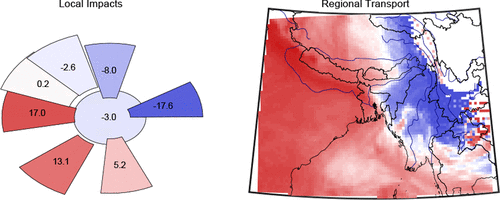当前位置:
X-MOL 学术
›
ACS Earth Space Chem.
›
论文详情
Our official English website, www.x-mol.net, welcomes your feedback! (Note: you will need to create a separate account there.)
Distinguishing Air Pollution Due to Stagnation, Local Emissions, and Long-Range Transport Using a Generalized Additive Model to Analyze Hourly Monitoring Data
ACS Earth and Space Chemistry ( IF 3.4 ) Pub Date : 2021-08-23 , DOI: 10.1021/acsearthspacechem.1c00206 Benjamin de Foy 1 , Md. Golam Saroar 2 , Abdus Salam 3 , James J. Schauer 4, 5
ACS Earth and Space Chemistry ( IF 3.4 ) Pub Date : 2021-08-23 , DOI: 10.1021/acsearthspacechem.1c00206 Benjamin de Foy 1 , Md. Golam Saroar 2 , Abdus Salam 3 , James J. Schauer 4, 5
Affiliation

|
Long-term surface monitoring of hourly <2.5 μm diameter particulate matter (PM2.5) concentrations in megacities provides an essential record to estimate adverse health effects experienced by many people. In addition, hidden from immediate view, the time series of measurements contains a wealth of information on the types of sources and the impact of meteorology. A generalized additive model (GAM) was developed to analyze multiple years of hourly data in order to distinguish the sources leading to adverse air quality and the response of the concentrations to boundary layer mixing, wind transport, and precipitation. The model estimates the impact of long-range transport by using clusters of back-trajectories and a trajectory cluster contribution function. Estimates of emissions from wildfires and agricultural biomass burning based on multisatellite remote sensing were combined with back-trajectories to estimate the impacts at the measurement sites. The method was applied to Dhaka, Bangladesh, and Kolkata, India, for the dry season from November to March for up to 7 years of data. Weak winds and low mixing heights lead to very low ventilation coefficients, which contribute to extreme air pollution events. The contribution of local emissions was inferred from the variability in the measured concentrations that could be attributed to the boundary layer height, the local winds, and the diurnal cycle. By this method, local emissions were estimated to contribute between 57% and 67% of the aerosol concentrations. Long-range air mass transport from the Indo-Gangetic plain was associated with concentrations that were 40% higher than when the winds blew from the east. Wildfires and agricultural biomass burning were estimated to increase PM2.5 by 7–8% over the long-term baseline. Overall, regional factors were estimated to contribute between 31% and 37% of the variability. Weekdays and holidays were found to have very limited impacts on the PM2.5 concentrations. Model residuals in Dhaka highlight the need to measure more accurately the low wind speeds and shallow mixing heights in order to improve the characterization of emission sources. By integrating back-trajectories and fire emission estimates into the GAM simulations, this study provides estimates of local versus regional pollution and quantifies the impact of meteorology on air quality in the region. Furthermore, the approach can be readily adapted to many locations with limited air quality management infrastructure.
中文翻译:

使用广义加法模型分析每小时监测数据,区分由于停滞、局部排放和远程传输造成的空气污染
对每小时直径 <2.5 μm 的颗粒物 (PM 2.5) 大城市中的浓度为估计许多人所经历的不利健康影响提供了重要记录。此外,从直接角度看,测量的时间序列包含大量关于源类型和气象影响的信息。开发了一个广义加性模型 (GAM) 来分析多年的每小时数据,以区分导致不良空气质量的来源以及浓度对边界层混合、风传输和降水的响应。该模型通过使用反向轨迹集群和轨迹集群贡献函数来估计远程传输的影响。基于多卫星遥感的野火和农业生物质燃烧的排放估计与回溯相结合,以估计测量地点的影响。该方法应用于孟加拉国达卡和印度加尔各答,从 11 月到 3 月的旱季数据长达 7 年。弱风和低混合高度导致非常低的通风系数,从而导致极端空气污染事件。当地排放的贡献是从测量浓度的可变性推断出来的,这些可变性可归因于边界层高度、当地风和昼夜循环。通过这种方法,估计局部排放占气溶胶浓度的 57% 至 67%。来自印度-恒河平原的远程气团输送与比东风吹来时高 40% 的浓度有关。野火和农业生物质燃烧估计会增加 PM2.5比长期基线高 7-8%。总体而言,估计区域因素对可变性的贡献介于 31% 至 37% 之间。发现工作日和节假日对 PM 2.5浓度的影响非常有限。达卡的模型残差强调需要更准确地测量低风速和浅层混合高度,以改进排放源的表征。通过将回溯轨迹和火灾排放估计值整合到 GAM 模拟中,本研究提供了局部与区域污染的估计值,并量化了气象对该区域空气质量的影响。此外,该方法可以很容易地适应许多空气质量管理基础设施有限的地方。
更新日期:2021-09-16
中文翻译:

使用广义加法模型分析每小时监测数据,区分由于停滞、局部排放和远程传输造成的空气污染
对每小时直径 <2.5 μm 的颗粒物 (PM 2.5) 大城市中的浓度为估计许多人所经历的不利健康影响提供了重要记录。此外,从直接角度看,测量的时间序列包含大量关于源类型和气象影响的信息。开发了一个广义加性模型 (GAM) 来分析多年的每小时数据,以区分导致不良空气质量的来源以及浓度对边界层混合、风传输和降水的响应。该模型通过使用反向轨迹集群和轨迹集群贡献函数来估计远程传输的影响。基于多卫星遥感的野火和农业生物质燃烧的排放估计与回溯相结合,以估计测量地点的影响。该方法应用于孟加拉国达卡和印度加尔各答,从 11 月到 3 月的旱季数据长达 7 年。弱风和低混合高度导致非常低的通风系数,从而导致极端空气污染事件。当地排放的贡献是从测量浓度的可变性推断出来的,这些可变性可归因于边界层高度、当地风和昼夜循环。通过这种方法,估计局部排放占气溶胶浓度的 57% 至 67%。来自印度-恒河平原的远程气团输送与比东风吹来时高 40% 的浓度有关。野火和农业生物质燃烧估计会增加 PM2.5比长期基线高 7-8%。总体而言,估计区域因素对可变性的贡献介于 31% 至 37% 之间。发现工作日和节假日对 PM 2.5浓度的影响非常有限。达卡的模型残差强调需要更准确地测量低风速和浅层混合高度,以改进排放源的表征。通过将回溯轨迹和火灾排放估计值整合到 GAM 模拟中,本研究提供了局部与区域污染的估计值,并量化了气象对该区域空气质量的影响。此外,该方法可以很容易地适应许多空气质量管理基础设施有限的地方。



























 京公网安备 11010802027423号
京公网安备 11010802027423号